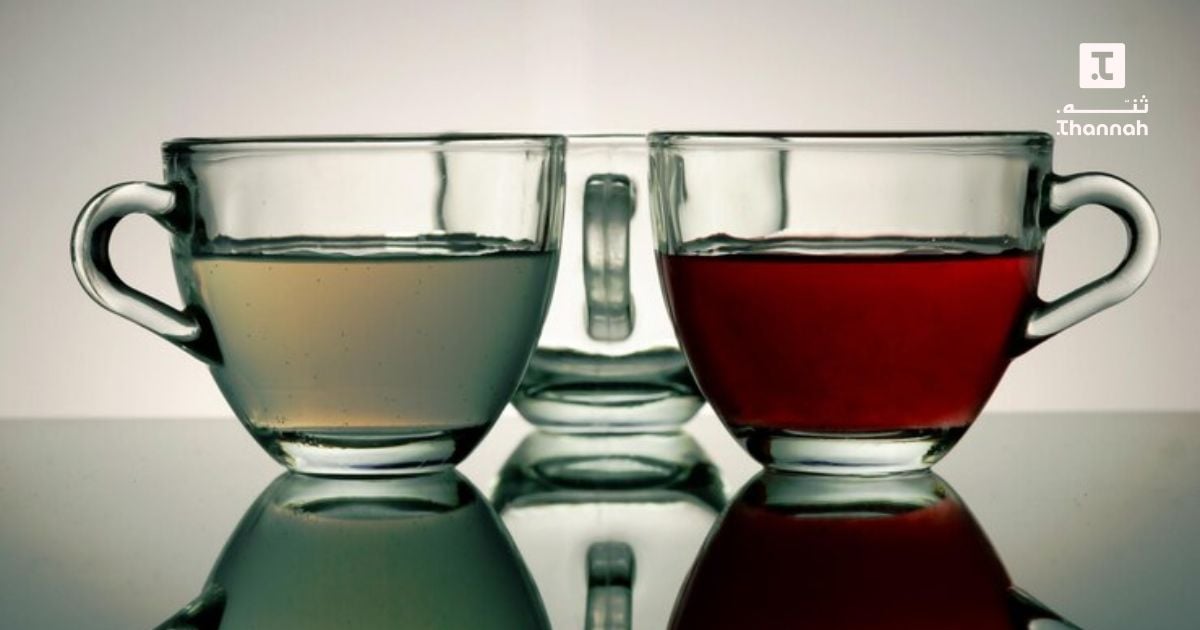Tea comes in many varieties, including red and green. Technically, to be classified as tea, it must be extracted from the Camellia sinensis plant, like green tea. However, many of the drinks people call tea, including red tea, are not extracted from this plant. Both red and green tea are associated with many purported health benefits, which we will learn about with Thana Store, the best tea and coffee store in Saudi Arabia .
What is green tea?
Green tea is completely different from red tea. It is completely oxidized and largely retains the properties of the natural leaves it is made from. It comes from the Camellia sinensis plant and is known for its beneficial plant compounds. Its name is associated with numerous health benefits, particularly weight loss and weight management.
Its color is bright green, and the darker the more leaves are used or the longer they are steeped. Today, green tea has become a strong competitor to red or black tea, and is a daily beverage for many Saudis.
What is red tea?
Red tea, also known as black tea in some cultures, is the natural result of processing the tea plant's leaves after undergoing special oxidation processes. When prepared, the leaves are steeped in boiling water. The color of the resulting beverage varies depending on the length of time it is steeped and the concentration of the leaves used, ranging from deep red to reddish-black. This color variation reflects the concentration of natural compounds, such as tannins and caffeine, which determine the tea's taste and strength.
This tea is popular in many cultures around the world, but it is one of the most important drinks in Arab and Saudi culture.

The difference between green and red tea: the origins
Everything has a beginning, and every type has an origin and a story. Below, we will learn about the origins of both red and green tea:
green tea
Green tea is grown and marketed in many places around the world, including China, Taiwan, Japan, New Zealand, and India. All green teas produced come from the same plant species. Shennong, the Emperor of China and founder of Chinese medicine, is said to have discovered tea as a beverage in 2737 BC when some tea leaves from a surrounding tea tree fell into a cup of freshly boiled water. This beverage became the green tea that most people know today.
red tea
Red rooibos is a broom-like plant in the legume family, with roots growing up to three meters deep in the soil in the western part of South Africa, in a remote mountainous region known as the Cederberg. As a result, it produces needle-like leaves and yellow flowers, the perfect ingredient for making red tea. Red tea dates back to 1902 and is enjoyed today in many countries around the world.
The difference between green and red tea: the production process
The production process for green and red tea differs, and the most important stages for each type are as follows:
green tea
Green tea is prepared and grown in many ways, depending on the type of green tea desired. Growing conditions are divided into two categories: sun-grown and shade-grown. The second harvest is usually picked in June and July, while the third harvest is in July or August. After picking, the tea leaves must be dried to avoid aging or fermentation. The tea leaves are spread out on wooden straws or bamboo racks and placed under direct sunlight or hot air. The tea leaves are turned over again to ensure even drying.
red tea
In the summer months of March, the seeds are sown in well-prepared beds to initiate rooibos production. The first crop is harvested after a year and six months. The harvest season lasts from January to April. The dense African shrub is cut by hand, and its leaves and stems are gathered into bundles. When collected, the bundles are separated and then cut or crushed to stimulate oxidation. The active compounds and oils of the plant are extracted by oxidation or exposure to oxygen. This also helps the leaves acquire their texture and rich flavor.
The difference between green and red tea: benefits
Even the benefits differ between red and green tea, as each type has its own unique benefits that it offers you just by drinking one cup of it:
Benefits of green tea
The most important and prominent features and benefits of drinking green tea are:
- Green tea contains epigallocatechin-3-gallate (EGCG), a powerful antioxidant that effectively prevents cell damage.
- Green tea's ability to treat various disorders is linked to its high levels of EGCG, a compound known for its ability to protect cells and biomolecules from oxidative damage by reducing the formation of harmful free radicals.
- Boosts brain activity: Green tea may help increase brain function and maintain alertness. Caffeine, a well-known stimulant, is present in this tea, which contains high levels of caffeine, just like coffee.
- Green tea also contains the amino acid L-theanine, which can cross the blood-brain barrier. L-theanine stimulates GABA, an inhibitory neurotransmitter with anti-anxiety properties.
- Green tea helps reduce body fat by increasing metabolism, enhancing fat burning and metabolic activity. Studies have shown that green tea also helps promote weight loss, especially in the abdominal area.
- It also contains a range of important vitamins, such as vitamin A, which strengthens the immune system, protects eye health, and helps delay the appearance of premature signs of aging on the skin and joints.
Benefits of red tea
Now let's learn together about the benefits of red tea, which are:
- Improves skin texture and appearance. Alpha hydroxy acid, found in red tea, is a key ingredient in cosmetic procedures, and clinical studies have shown it promotes bone health.
- The soothing effect of red tea reduces inflammation and redness, resulting in more even skin tone.
- Zinc, found in red tea, has also been shown to help treat common skin disorders, including eczema and acne.
- Red tea provides superoxide dismutase, an anti-aging enzyme that prevents wrinkles.
- Like other types of tea and many herbal drinks, red tea contains minerals that promote bone health, such as magnesium, fluoride, and calcium. These minerals regulate the biological activity of bone-building cells and are essential for the formation of strong bones.
- Red tea contains the flavonoid chrysodiol, a bronchodilator that helps lower high blood pressure and improve blood circulation.
- According to studies, aspalathin in red tea may help manage diabetes symptoms and prevent serious conditions, including heart disease and stroke.
Order from Thana Store the best Saudi tea, rich in benefits and free of harms. Add it to your cart now.
The difference between green and red tea: harms
Both red and green tea have their share of harms. Despite their many benefits, neither is without harms:
Harmful effects of red tea
Moderation is required, especially when consuming red tea. The most important harms resulting from excessive consumption are:
- Poor iron absorption in the blood : Red tea leaves contain a percentage of tannins, which are compounds that bind to iron in the digestive system and limit its absorption.
- Digestive problems : Drinking too much red tea, especially on an empty stomach, may cause digestive problems and nausea.
- Increased anxiety levels : As we know, red tea contains large amounts of caffeine, which in turn raises the heart rate and increases levels of stress and anxiety.
- Headaches and sleep disturbances : The caffeine in black tea can still cause side effects such as headaches and sleep disturbances.
- Pregnancy complications and risks : Drinking this tea during pregnancy increases the risk of premature birth and the likelihood of miscarriage.
Harmful effects of green tea
You might wonder how green tea can be harmful? Studies have shown that there is a 30% chance that this tea is the primary cause of many harmful effects, including:
- Stomach irritation : Drinking green tea on an empty stomach can cause stomach irritation, as it contains tannins that may increase the amount of acid in the stomach.
- Diarrhea : The laxative effect of caffeine in green tea stimulates the colon muscles to contract and excrete more frequently.
- Anemia and iron deficiency : The antioxidants in this tea may reduce iron absorption in the blood.
- Dizziness and cramps : The caffeine in this tea can cause dizziness and lightheadedness, especially when consumed in large quantities.
- Bleeding disorders : In rare cases, green tea may cause bleeding disorders. The compounds in it reduce levels of fibrinogen, a protein that helps blood clot. This tea also prevents the oxidation of fatty acids, which leads to blood thinning.
- Liver disease : Excessive consumption of green tea can cause liver damage, and scientists believe this is due to caffeine, which strains the liver.
Read also about 6 health and body benefits of African rooibos tea . Learn about them.

Other differences that explain the difference between green and black tea
There are still other fundamental differences between black and green tea, and these differences are clear in the following:
- Taste and Flavor : Red tea has a rich flavor that is evident from the first sip, blending the strength of the flavor with a slight hint of bitterness that becomes more pronounced as the drink cools. In contrast, green tea offers a calm flavor with a natural herbal aroma.
- Calories : When looking at red tea, we find that it is a completely calorie-free beverage as long as it is prepared without additives such as sugar or milk. Green tea, on the other hand, contains a very small amount of calories.
- Nutritional value : Although black tea is rich in natural stimulants, the preparation process may reduce its nutritional value, unlike green tea, which retains its nutritional composition thanks to the simple processing methods it undergoes.
- When to drink : Black tea is a daily companion that you can enjoy in the morning and evening, while green tea is recommended before bed or at the end of the day due to its high ability to relax.
- Caffeine content : The caffeine content in green tea and red tea differs. The former contains a lower caffeine content, equivalent to 28 mg per cup, while the latter contains up to 48 mg per cup.
Which is better for you, green tea or red tea?
The best and most suitable drink for you depends on your personal preferences and needs. If you want a quick and powerful boost of energy, try red tea. If your priority is supporting your health, green tea is best. Only experimentation is your only quick and effective way to judge which is best in terms of flavor, taste, and effect.
The best types of tea are available at Thana Store.
If the best types of tea have an address, it is in Thana, the best Saudi tea and coffee shop, which provides you with two types of tea products that every Saudi loves and presents as a symbol of love to his most beloved ones. Jamr tea With its strong aroma and flavor that will keep you yearning for one cup after the next, Shamali tea, with its light taste and refreshing aroma, will be a must-have for your family gatherings. Order the best Saudi tea now and enjoy a taste and flavor that will awaken your senses and soothe your nerves.
Frequently Asked Questions
Is green tea better or red?
Yes, green tea is superior in terms of its benefits and positive impact on health, when compared to red tea and its effects.
Which tea is better, green or red?
Green tea is definitely better because it contains antioxidants that benefit the body and overall health. Red tea also contains antioxidants, but they are not as strong as green tea.
Is red tea the same as green tea?
Yes, some studies confirm that red tea is basically green tea that has been dried and fermented to reach the familiar black color.
What is the difference between regular tea and green tea?
The main difference between regular tea and green tea is in the appearance. Regular tea is dark reddish in color, while green tea is light green. There is also another difference in taste and flavor.
Can black tea be mixed with green tea?
Yes, it is possible to mix green tea with red tea, but you will not like the resulting flavor at all.

